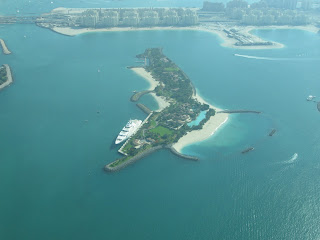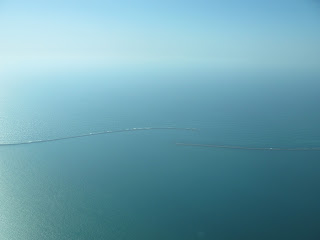Early
on in Abu Dhabi, I started making a list of things to do while I was here. You are witness to that list, as I’ve
steadily been marking things off, and posting about them on this blog.
When
events and activities are brought to my attention, I decided to
take a “why not” attitude and partake when possible.
One
of those events was the Dubai Lit Fest. My brother and sister-in-law had
brought home a brochure on this annual event.
First of all, I love books and reading.
Second, I saw names I recognized.
For a list of authors at the 2013 Lit Fest:
http://www.emirateslitfest.com/authors (this web page includes link to the author's websites).
The
theme for the 2013 Lit Fest was Heroes and Villains.
I
am an eclectic reader. One of the genres I enjoy is intrigue and criminal
mysteries.
I
was excited to see an author whose work I enjoy: Ian Rankin. He has a
multi-volume series with a character named John Rebus, a policeman in Edinburgh
with some dark and cranky characteristics.
I enjoy Rankin’s writing style.
With
the Lit Fest, you sign up for individual author talks. I think Ian Rankin’s was
60 Dirhams (about $16 USD). The Lit Fest is held at the Intercontinental in
Dubia’s Festival City. It’s along a portion of the Dubai Creek, and includes a
wide pedestrian area and many different restaurants.
Once
I found the place, I perused the offerings further, and selected a couple of
other speakers in addition to Ian Rankin.
The
first I attended was with Lynda La Plante.
The format at the Dubai Lit Fest is an interview style with the author or authors. I had never
heard of Lynda La Plante, or read any of her novels. I had, however, heard of
some of the tv shows that she has written and produced, including “Prime
Suspect” with Helen Mirren.
La
Plante was a kick and great fun to listen to. She’s maybe five-foot-nothing.
Maybe. She had me and the rest of the audience laughing most of the time. And when not laughing, she had us practically at the edge of our seats as she shared about her research for her books. Earlier in her career, she was an actress on
a British soap opera. She shared how she
got into writing for television, and basically it had to do with dull scripts
with unintelligent female characters, and she wanted to change that.
The
book I ended up purchasing and having her sign was “The Red Dhalia”. A fun read, a murder mystery type genre. After
the authors talk/are interviewed, most if not all of them sit at tables and autograph their
books. Couldn’t resist, given how much I enjoyed her interview. And when I got to the table, she was just as
down to earth and friendly as she was on stage. Someone who seems she would be
great fun to know and hang out with.
While I stood there and she signed the book, she shared that in writing and researching this particular book (she drew on the Black Dhalia case as a
parallel plot to her novel), she had the opportunity to speak to the son
of the primary suspect in the Black Dhalia murder investigation. And the son is
convinced to this day that is father was the Black Dhalia murderer.
Ian
Rankin was also down to earth and as humble as can be. As you well might know,
I am not a novelist, so can only guess at processes that authors go through.
And from other authors I’ve heard interviewed over time, the majority (?) seem
to develop a plot outline and know from start to finish how the book will
go. Some things he shared that I found
unique and very interesting:
- If he knew the end of the book he wouldn’t need to write the book. Apparently, he enjoys discovering along with the characters where the plot will go next.
- With the first draft, he is in the shoes of the main character, John Rebus. Ian Rankin doesn’t know until close to the end, who is the murderer/criminal. And “it’s a relief” to himself and to his editor when he figures it out.
- He describes the city of Edinburgh as “doing something enjoyable and trying hard not to show you are enjoying it.”
- To write a novel, is to “create an alternative universe where you can play God.”
- When he first began the John Rebus books, he started with a fake Edinburgh. He found he needed to use the real Edinburgh, and that it was easier too … pubs, streets, police stations, people’s titles … but not real people. What happened is that readers of his books were visiting Edinburgh, and looking for the fake places in the first books.
- He was “horrified” when his first book was placed in “crime fiction” in a bookstore. He had not read that genre himself, and did not think that is where is book belonged. He would move his books to the Scottish Literature section. And back they’d go to the crime fiction section. He eventually embraced this.
- His novel “Hide and Seek” is an homage to Jekyl and Hyde.
- He wrote three thrillers under another name. For these, he included more details than he does with the Rebus series. For example in these earlier thrillers, he might go into great length of the details of a gun.
- For one of his earliest books, “Knotts and Crosses”, he was doing research. What he didn’t realize was that there was a similar story in the news, to what he was writing about. It was so similar, that as he started to ask questions of some police at the station (researching), they ended up saying to him “let’s assume you’re a suspect”, and he thought this was a way for them to share how things work. They talked to him for quite awhile … for a bit they actually thought they had their murderer in the station. He avoided the police for several years after that, until another policeman offered to help him with legal and police processes, procedures, etc. for authenticity.
- He said that the novel needs to reflect real life, needs to be realistic. He recounted a story about a criminal who was caught, because of what a witness saw: the witness was mowing his lawn with a pushmower. He bent over to move a rock out of the way, and saw an adult’s legs and a child’s legs, and the child’s legs being picked up and the child going into to vehicle, not by choice. (If my memory serves, they caught the guy, based on this one moment in time.)
- Rankin keeps a “big book of ideas” for story lines.
- His character John Rebus has aged right along with the books and the stories’ timelines. There is such a big fan base in Edinburgh, that when John Rebus retired in the books, someone asked Scottish Parliament to raise the police retirement age so that John Rebus could continue as a character in the books! Rebus has retired, but the latest book has him volunteering in cold case files for the police, to stay involved.
- His ongoing character of Siobhan, a colleague of Rebus’, “asks the questions the read wants to know.”
In
another session, I saw Jeffery Deaver and Anthony Horowitz interviewed. Both are well known authors. They were paired
in this session because this past year they were, in my words, “guest authors”
in a fiction series. Deaver wrote the
latest Bond novel, “Carte Blanche”, and it will be the only Bond novel for him,
by choice. He grew up reading Ian Fleming’s novels, so this had to be a kick
for him. Deaver uses outlines for his
stories. Horowitz has written the latest
Sherlock Holmes novel, “The Silk Road”.
He said he felt almost like he channeled Arthur Conan Doyle, and the
story just flowed. He’s a big fan of that genre of literature, as well as that
period, and it seems he would like to write more. Critics say that he
completely echoes Doyle’s voice and style.
While
I bought Horowitz “The Silk Road”, the line for his autograph just never died
down, so I never was able to get his autograph in the book. (Just finished reading the book, and enjoyed it.) I was successful in meeting
Jeffery Deaver and gaining his autograph in three books. I picked up a spare of
“Carte Blanche” for my brother (both a big reader and Bond fan), and a copy of
“XO”, a recent mystery in one of Deaver’s series. Both I enjoyed reading. But more so I enjoyed meeting
him. He was friendly and personable, and spent quite a bit of time with each person in
line. A young woman in front of me asked for a photo with him, and he wanted one as well. So, I gladly
took their photograph with Jeffery Deaver’s camera.
The
one other session I attended was an interview with Dan Rather. A packed room,
as you can imagine. He was making this stop on his way to Afghanistan. It was very cool, to sit a room and listen
to a voice that we have all heard for so many years. The topics and issued discussed varied, and I
should have taken notes, but it was too much fun to just sit and listen. I
think Dan Rather is another person who would be fabulous to sit and have a
conversation with for a few hours. (I
don’t believe he did a book signing; I never saw that line, and had there been
one, it would have been loooong.)
I
just attended one day of the Lit Fest. And it made me wonder why I have never
taken advantage of the Los Angeles Time Festival of Books. A new item on my
list of things to do in my own back yard.





















